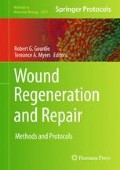Abstract
A challenge to the study of regeneration is determining at what point the processes of wound healing and regeneration diverge. The mouse displays level-specific regeneration responses. An amputation through the distal third of the terminal phalanx will prompt a regeneration response and result in a new digit tip that mimics the morphology of the lost digit tip. Conversely, an amputation through the distal third of the intermediate phalanx initiates a wound healing and scarring response. The mouse, therefore, provides a model for studying the transition between wound healing and regeneration in the same animal. This chapter details the methods used in the study of mammalian digit regeneration, including a method to introduce exogenous protein into the mouse digit amputation model via microcarrier beads and methods for analysis of bone regeneration.
Access this chapter
Tax calculation will be finalised at checkout
Purchases are for personal use only
References
Dinsmore CE (ed) (1991) A history of regeneration research: milestones in the evolution of a science. Cambridge University Press, Cambridge
Tanaka EM, Reddien PW (2011) The cellular basis for animal regeneration. Dev Cell 21:172–185
Stocum DL, Cameron JA (2011) Looking proximally and distally: 100 years of limb regeneration and beyond. Dev Dyn 240:943–968
McKim LH (1932) Regeneration of the distal phalanx. Can Med Assoc J 26:549–550
Douglas BS (1972) Conservative management of guillotine amputation of the finger in children. Aust Paediatr J 8:86–89
Allen MJ (1980) Conservative management of finger tip injuries in adults. Hand 12:257–265
Han M, Yang X, Lee J, Allan CH, Muneoka K (2008) Development and regeneration of the neonatal digit tip in mice. Dev Biol 315:125–135
Reginelli AD, Wang YQ, Sassoon D, Muneoka K (1995) Digit tip regeneration correlates with regions of Msx1 (Hox 7) expression in fetal and newborn mice. Development 121:1065–1076
Neufeld DA, Zhao W (1995) Bone regrowth after digit tip amputation in mice is equivalent in adults and neonates. Wound Repair Regen 3:461–466
Borgens RB (1982) Mice regrow the tips of their foretoes. Science 217:747–750
Clark RA (ed) (1995) The molecular and cellular biology of wound repair, 2nd edn. Plenum Press, New York
Fernando WA, Leininger E, Simkin J, Li N, Malcom CA, Sathyamoorthi S, Han M, Muneoka K (2011) Wound healing and blastema formation in regenerating digit tips of adult mice. Dev Biol 350:301–310
Han M, Yang X, Farrington JE, Muneoka K (2003) Digit regeneration is regulated by Msx1 and BMP4 in fetal mice. Development 130:5123–5132
Yu L, Han M, Yan M, Lee EC, Lee J, Muneoka K (2010) BMP signaling induces digit regeneration in neonatal mice. Development 137:551–559
Ros MA, Lopez-Martinez A, Simandl BK, Rodriguez C, Izpisua Belmonte JC, Dahn R, Fallon JF (1996) The limb field mesoderm determines initial limb bud anteroposterior asymmetry and budding independent of sonic hedgehog or apical ectodermal gene expressions. Development 122:2319–2330
Ganan Y, Macias D, Duterque-Coquillaud M, Ros MA, Hurle JM (1996) Role of TGF beta s and BMPs as signals controlling the position of the digits and the areas of interdigital cell death in the developing chick limb autopod. Development 122:2349–2357
Ferguson CM, Schwarz EM, Puzas JE, Zuscik MJ, Drissi H, O'Keefe RJ (2004) Transforming growth factor-beta1 induced alteration of skeletal morphogenesis in vivo. J Orthop Res 22:687–696
Subramanian S (1984) Dye-ligand affinity chromatography: the interaction of Cibacron Blue F3GA with proteins and enzymes. CRC Crit Rev Biochem 16:169–205
Fallon JF, Lopez A, Ros MA, Savage MP, Olwin BB, Simandl BK (1994) FGF-2: apical ectodermal ridge growth signal for chick limb development. Science 264:104–107
Schreiber AB, Winkler ME, Derynck R (1986) Transforming growth factor-alpha: a more potent angiogenic mediator than epidermal growth factor. Science 232:1250–1253
Li S, Muneoka K (1999) Cell migration and chick limb development: chemotactic action of FGF-4 and the AER. Dev Biol 211:335–347
Brady J (1965) A simple technique for making very fine, durable dissecting needles by sharpening tungsten wire electrolytically. Bull World Health Organ 32:143–144
Erben RG (2003) Bone-labeling techniques. In: An YH, Martin KL (eds) Handbook of histology methods for bone and cartilage. Humana Press Inc., Totowa, pp 99–117
Neufeld DA, Mohammad KS (2000) Fluorescent bone viewed through toenails of living animals: a method to observe bone regrowth. Biotech Histochem 75:259–263
Doube M, Klosowski MM, Arganda-Carreras I, Cordelieres FP, Dougherty RP, Jackson JS, Schmid B, Hutchinson JR, Shefelbine SJ (2010) BoneJ: free and extensible bone image analysis in ImageJ. Bone 47:1076–1079
Schmid B, Schindelin J, Cardona A, Longair M, Heisenberg M (2010) A high-level 3D visualization API for Java and ImageJ. BMC Bioinformatics 11:274
Author information
Authors and Affiliations
Editor information
Editors and Affiliations
Rights and permissions
Copyright information
© 2013 Springer Science+Business Media New York
About this protocol
Cite this protocol
Simkin, J., Han, M., Yu, L., Yan, M., Muneoka, K. (2013). The Mouse Digit Tip: From Wound Healing to Regeneration. In: Gourdie, R., Myers, T. (eds) Wound Regeneration and Repair. Methods in Molecular Biology, vol 1037. Humana Press, Totowa, NJ. https://doi.org/10.1007/978-1-62703-505-7_24
Download citation
DOI: https://doi.org/10.1007/978-1-62703-505-7_24
Published:
Publisher Name: Humana Press, Totowa, NJ
Print ISBN: 978-1-62703-504-0
Online ISBN: 978-1-62703-505-7
eBook Packages: Springer Protocols

